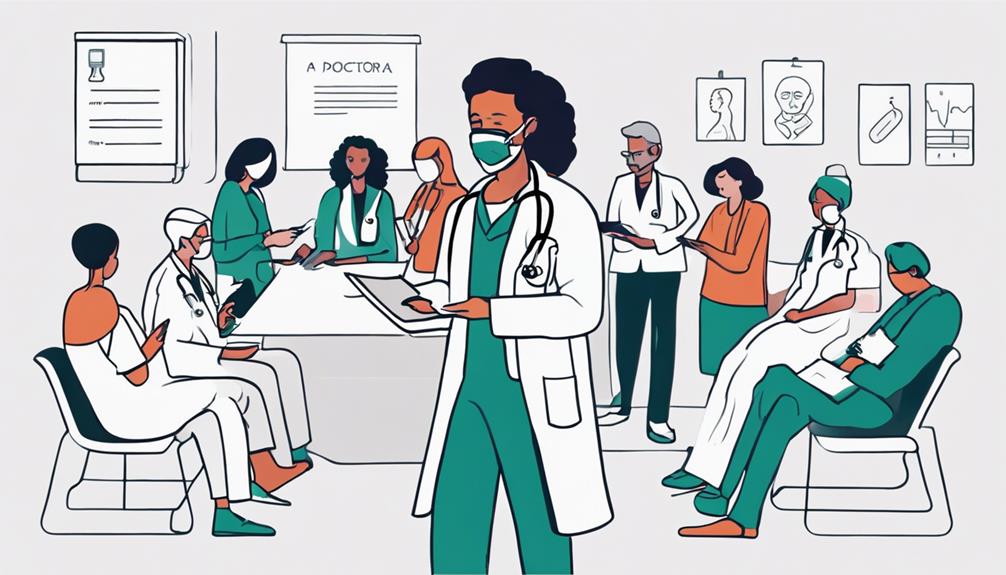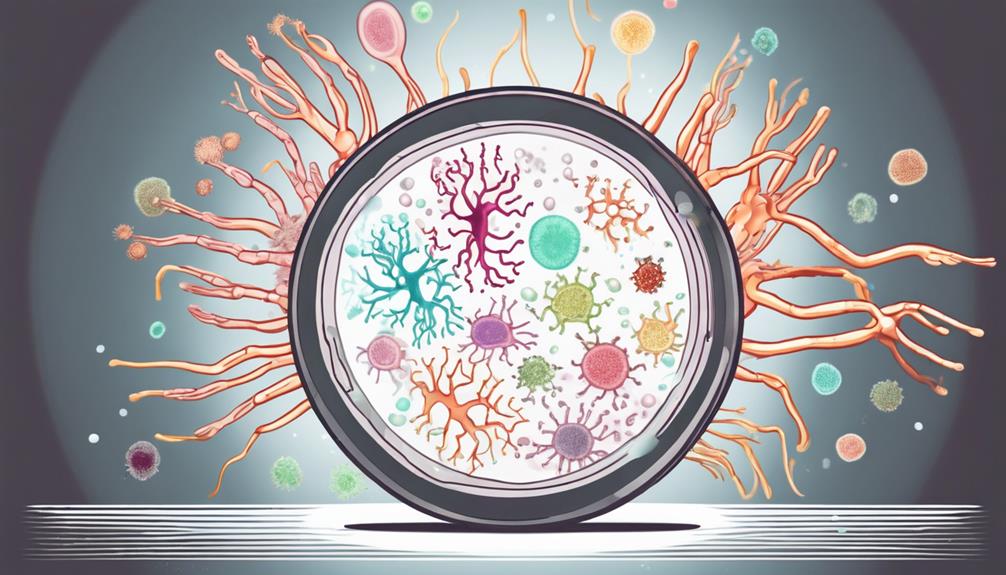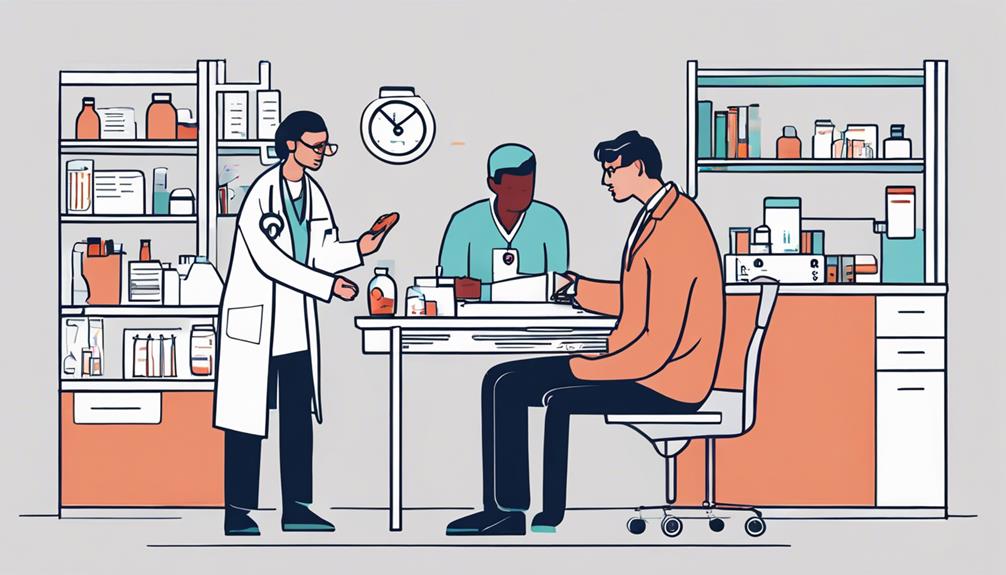In the realm of combating antibiotic resistance, a critical evaluation of our current methods is imperative. As the efficacy of antibiotics diminishes in the face of evolving resistance mechanisms, it becomes increasingly crucial to explore innovative solutions. By delving into the complexities of this global health challenge, we can uncover novel strategies that may hold the key to overcoming antibiotic resistance. Through a systematic and comprehensive approach, we can pave the way for a future where antibiotics remain a cornerstone of modern medicine.
Key Takeaways
- Implement stringent infection control measures to prevent resistant bacteria transmission.
- Promote responsible antibiotic usage to curb resistance development.
- Enhance surveillance of resistance patterns for early detection and containment.
- Support the development of new antibiotics to combat evolving resistant strains.
Understanding Antibiotic Resistance

Antibiotic resistance is a complex phenomenon that arises when bacteria evolve mechanisms to withstand the effects of antibiotics, rendering these medications ineffective in combating bacterial infections. Bacteria, through genetic mutations or acquiring resistance genes from other bacteria, can develop strategies to neutralize the actions of antimicrobial drugs. This resistance poses a significant challenge to public health as it limits the effectiveness of antibiotics, leading to prolonged illnesses, increased healthcare costs, and higher mortality rates from once-treatable bacterial infections.
The misuse and overuse of antibiotics play a pivotal role in the development of antibiotic resistance. Factors such as not completing prescribed antibiotic courses, using antibiotics inappropriately for viral infections, or in agriculture contribute to the proliferation of resistant bacterial strains like MRSA. Consequently, these resistant bacteria can spread within communities and healthcare settings, making infections harder to treat. Understanding the mechanisms behind antibiotic resistance is crucial in guiding efforts to combat this growing public health threat.
Causes of Antibiotic Resistance
The emergence of antibiotic resistance in bacteria is a multifaceted issue influenced by various factors related to the use and misuse of antimicrobial agents. Bacterial resistance to antibiotics can occur through mutations in their genetic material or by acquiring resistance genes from other bacteria. Misuse of antibiotics, such as not completing prescribed courses or using them inappropriately, accelerates the development of resistant strains. Specific bacteria, like Methicillin-resistant Staphylococcus aureus (MRSA), have evolved to resist multiple antibiotics, posing significant challenges in treatment. The overuse of broad-spectrum antibiotics, inadequate infection control practices, and the use of antibiotics in livestock also contribute to the rise of resistant bacteria. Antibiotic resistance is a critical global concern as it compromises the effectiveness of antibiotic therapies, leading to prolonged illnesses, higher healthcare costs, and increased mortality rates. To combat this issue, it is crucial to promote judicious antibiotic use, develop novel treatment strategies, and implement stringent antibiotic stewardship programs.
Risk Factors for Antibiotic Resistance

The risk factors for antibiotic resistance encompass the overuse of antibiotics, inadequate infection control practices, and the extensive use of antibiotics in agriculture. These factors contribute to the development and spread of resistant bacteria, posing a significant threat to public health. Addressing these risk factors is crucial in combating the growing concern of antibiotic resistance.
Overuse of Antibiotics
Excessive utilization of antimicrobial agents poses a significant risk in fostering the development of antibiotic resistance within bacterial populations. Overuse of antibiotics accelerates this resistance, rendering these medications less effective against bacterial infections. The misuse of antibiotics, such as prescribing them for viral infections, further exacerbates the issue. Failing to complete prescribed antibiotic courses also contributes to the development of antibiotic-resistant strains. Individuals not adhering to proper antibiotic usage guidelines significantly impact the emergence of resistant bacteria. These practices collectively heighten the prevalence of antibiotic resistance, jeopardizing the effectiveness of these crucial medications in combatting bacterial infections.
Poor Infection Control
FIRST SENTENCE:
Inadequate infection control practices in healthcare settings significantly contribute to the proliferation of antibiotic-resistant bacteria. Poor hand hygiene, improper cleaning of medical equipment, and insufficient adherence to isolation protocols create favorable conditions for the development and spread of antibiotic resistance. Cross-contamination between patients due to lapses in infection control can facilitate the transmission of resistant infections within health care facilities. Outbreaks of antibiotic-resistant bacteria in hospitals and other healthcare settings are often linked to the failure to follow recommended infection control guidelines. It is imperative to prioritize strict adherence to infection control measures, including thorough handwashing and stringent disinfection protocols, to effectively combat the growing threat of antibiotic resistance in healthcare environments.
Agricultural Antibiotic Use
Agricultural practices play a pivotal role in the escalation of antibiotic resistance as the extensive use of antibiotics in livestock for growth promotion and disease prevention contributes significantly to the proliferation of resistant bacteria.
- Livestock receive a large portion of antibiotics for non-therapeutic purposes.
- Resistant bacteria from farms can be transmitted to humans through various pathways.
- Antibiotics used in agriculture can contaminate the environment and impact ecosystems.
- Regulations governing agricultural antibiotic use vary globally, affecting resistance development.
- Mitigating agricultural antibiotic use is crucial in combating the spread of antibiotic resistance in bacteria and preserving the effectiveness of these vital drugs.
Spread of Resistant Infections

The dissemination of antibiotic-resistant infections poses a significant challenge in public health due to their ability to spread through various modes of transmission. Resistant infections can be transmitted through direct contact, contaminated surfaces, and within healthcare settings where vulnerable individuals are concentrated. Resistant bacteria have the capacity to exchange genetic material, allowing them to acquire and enhance their resistance capabilities. Notable examples of antibiotic-resistant infections include MRSA and CRE, which have demonstrated high levels of resistance against commonly used antibiotics. Poor infection control practices, such as inadequate hand hygiene and improper sterilization techniques, play a pivotal role in the spread of these infections. The consequences of antibiotic-resistant infections are profound, leading to prolonged hospital stays, escalated healthcare costs, and elevated mortality rates. Addressing the spread of antibiotic-resistant infections demands a multifaceted approach that encompasses stringent infection control measures, prudent antibiotic use, and continuous surveillance to curb the dissemination of these formidable pathogens.
Diagnosis and Treatment Options
Proper diagnosis and treatment of antibiotic-resistant infections are essential components in combating the spread of these formidable pathogens within healthcare settings and the community. When addressing antibiotic resistance, several key factors come into play:
- Specialized Diagnosis: Specialized tests may be required to confirm antibiotic resistance in bacterial infections, ensuring that the most effective treatment is administered.
- Treatment Options: Alternative antibiotics or combination therapies are often necessary for combating antibiotic-resistant infections when standard antibiotics fail to work effectively.
- Consultation with Specialists: Infectious disease specialists play a crucial role in managing antibiotic resistance, providing expertise in navigating complex cases and tailoring treatment plans accordingly.
- Early Detection: Early detection of antibiotic-resistant infections is vital in preventing their spread, highlighting the importance of prompt and accurate diagnosis for effective containment.
- Preventive Measures: Implementing appropriate treatment promptly can help prevent the dissemination of antibiotic-resistant bacteria, underscoring the significance of proactive healthcare practices.
Prevention Strategies for Antibiotic Resistance

Implementing stringent infection control measures is paramount in the battle against antibiotic resistance, as it plays a pivotal role in preventing the proliferation of resistant bacteria. Proper handwashing is a simple yet effective way to reduce the spread of resistant bacteria and infections. Additionally, avoiding unnecessary antibiotic use and completing full antibiotic courses as prescribed are crucial in preventing the development of resistance. In healthcare settings, implementing robust infection control measures can significantly curb the emergence and spread of antibiotic resistance. Education on the appropriate use of antibiotics is also essential in combating resistance, as it promotes responsible antibiotic usage and helps individuals understand the consequences of misuse. To combat antibiotic resistance successfully, a multifaceted approach that includes these prevention strategies is vital for safeguarding public health and ensuring the effectiveness of current antibiotics while new drugs are developed.
| Prevention Strategies | Impact | Importance |
|---|---|---|
| Proper Handwashing | Reduces spread of resistant bacteria | High |
| Avoiding Unnecessary Antibiotics | Prevents development of resistance | Critical |
| Completing Full Antibiotic Courses | Reduces risk of resistance | Essential |
| Education on Antibiotic Use | Promotes responsible antibiotic usage | Crucial |
Frequently Asked Questions
How Can We Solve Antibiotic Resistance?
To solve antibiotic resistance, enhancing public awareness, implementing policy changes, advancing new research, fostering global cooperation, exploring alternative therapies, and promoting sustainable practices are essential. Public education on completing antibiotic courses, stringent policies on antibiotic use, innovation in new antibiotics, international collaboration, adoption of non-antibiotic treatments, and sustainable healthcare practices can collectively combat antibiotic resistance effectively. These strategies align with addressing the urgent global health threat posed by antibiotic resistance.
How Is Antibiotic Resistance Reduced?
Antibiotic resistance can be reduced through a multi-faceted approach. Public education on appropriate antibiotic use, drug development for new antibiotics, policy changes to regulate antibiotic prescribing, research funding for innovative solutions, stricter agricultural regulations to minimize antibiotic use in livestock, and global collaboration to address resistance on a larger scale are vital strategies. These combined efforts can help combat the growing threat of antibiotic resistance and preserve the effectiveness of these crucial medications.
How Can Individuals Prevent Antibiotic Resistance?
To prevent antibiotic resistance, individuals can adopt various strategies. Proper hygiene practices, such as thorough handwashing, play a crucial role in reducing infections that necessitate antibiotic use. Dietary changes towards a healthier lifestyle can boost immune function, reducing the need for antibiotics. Public education on the appropriate use of antibiotics and the importance of completing prescribed courses is essential. Exploring alternative therapies, limiting unnecessary antibiotic prescriptions, and considering probiotic supplements can also aid in combating resistance.
What Are 2 Strategies the US Is USing to Combat Antibiotic Resistance?
In the United States, strategies to combat antibiotic resistance include government initiatives focused on antibiotic stewardship programs and the promotion of prudent antibiotic use through clinical guidelines. Additionally, research funding is allocated for the development of new drugs and vaccines targeting resistant bacteria. Public awareness campaigns, in collaboration with agencies like the CDC, aim to educate the population on the proper use of antibiotics to prevent resistance and improve overall health outcomes.
Conclusion
In conclusion, the battle against antibiotic resistance requires a comprehensive and collaborative approach. As the saying goes, "United we stand, divided we fall." By promoting proper antibiotic use, investing in research, enhancing surveillance, and implementing prevention strategies, we can work together to combat this global health threat and ensure the continued efficacy of antibiotics for future generations.
